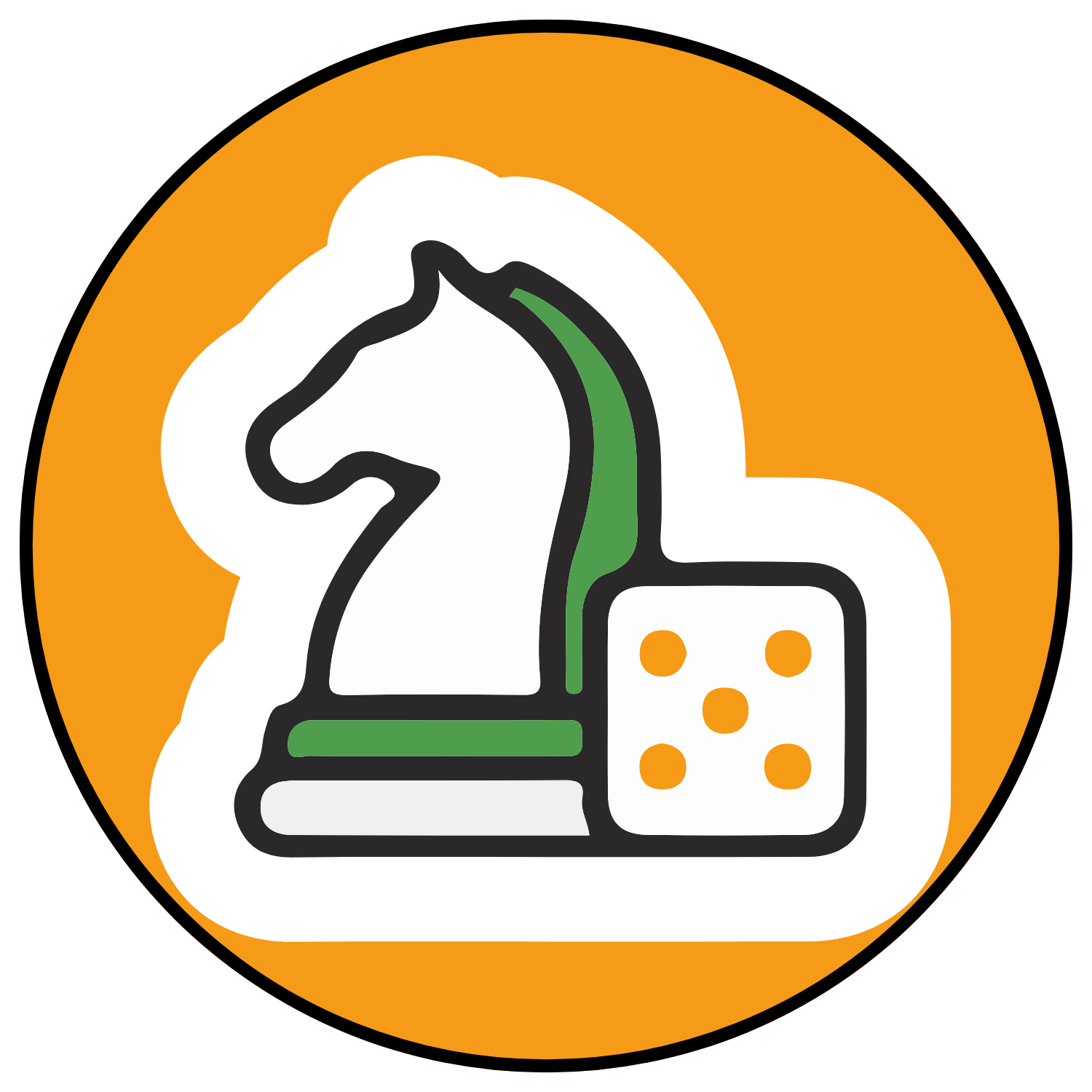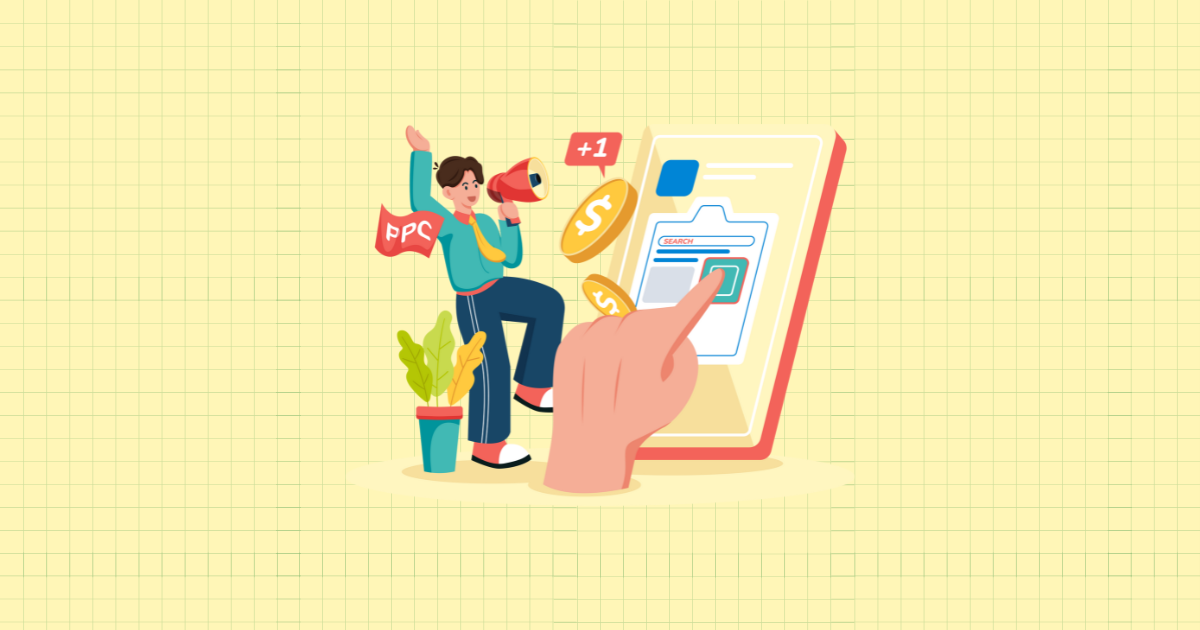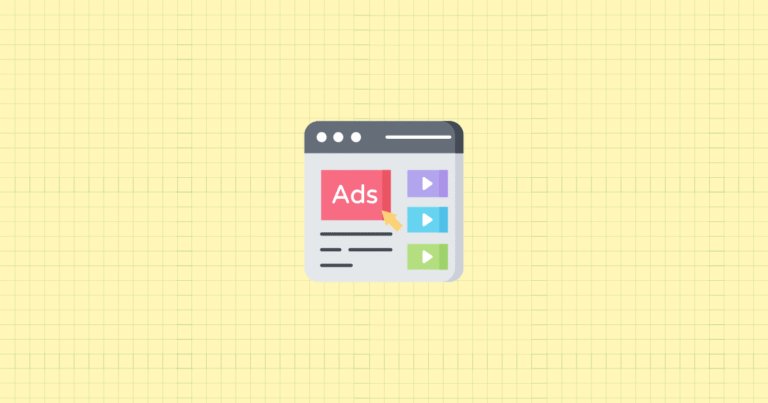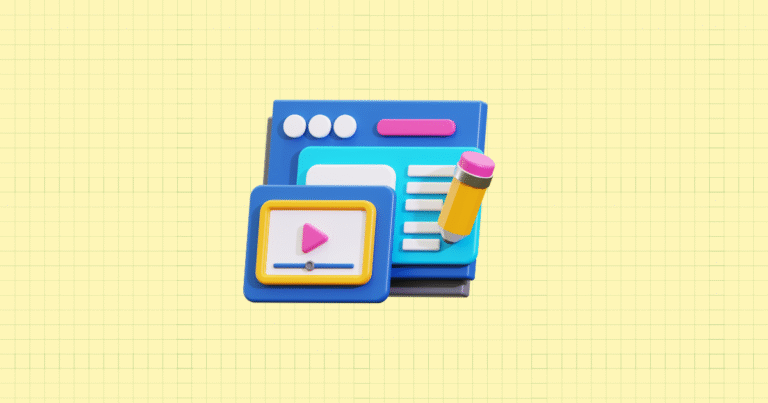Your Shopify store is beautiful. Your products are amazing. But here’s the brutal truth: nobody will find them if you’re waiting for organic traffic alone.
Paid advertising isn’t just an option for Shopify merchants anymore—it’s essential. The question isn’t whether you should advertise, but how to do it without destroying your brand’s reputation or burning through your budget faster than a Black Friday flash sale.
This comprehensive guide will walk you through every aspect of paid advertising for Shopify stores. You’ll discover proven strategies that protect your brand while driving real revenue growth. We’ll cover technical foundations, platform-specific tactics, and advanced optimization techniques that separate successful merchants from those still struggling to break even on their ad spend.
Understanding the Value of Paid Advertising for Shopify
Let’s start with something you probably already know but need to hear anyway: paid advertising works. When done right, it’s the fastest way to scale your Shopify store from a few sales per day to hundreds—or even thousands.
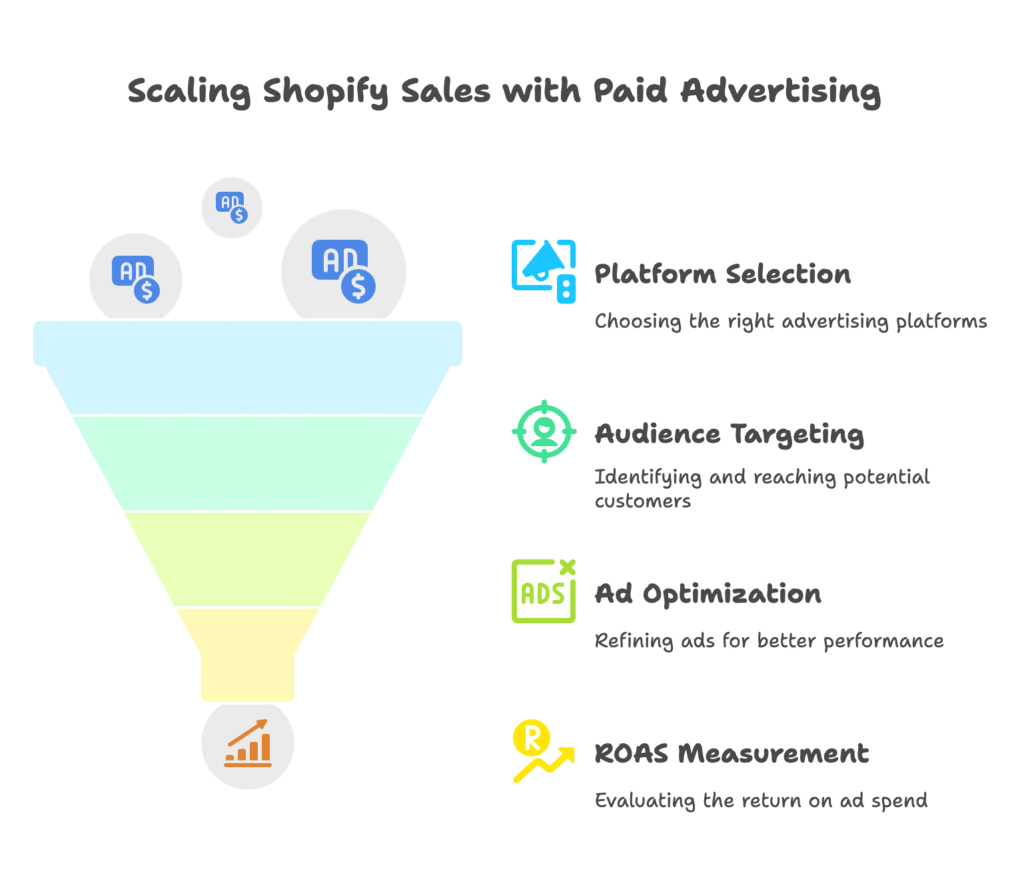
Why Paid Advertising Matters for Your Brand
Think of paid advertising as your store’s megaphone in a crowded marketplace. Without it, you’re whispering while your competitors are shouting through amplifiers.
The pay-per-click (PPC) model means you only pay when someone actually clicks on your ad. That’s already better than traditional advertising where you pay for impressions regardless of interest. But here’s where it gets interesting: modern PPC platforms use machine learning to show your ads to people most likely to buy.
Return on ad spend (ROAS) is your north star metric. Simply put, if you spend $100 on ads and generate $300 in revenue, your ROAS is 3:1. Most successful Shopify stores aim for at least 4:1 ROAS, though this varies by industry and profit margins.
The difference between paid search and paid social is crucial. Paid search catches people actively looking for your products. Paid social introduces your brand to people who might not know they need what you’re selling yet. Both have their place in your strategy.
Platform Selection: Where Your Customers Are Waiting
Not all advertising platforms are created equal. Your success depends on choosing the right ones for your specific audience and products.
Search advertising platforms like Google Ads and Microsoft Advertising (Bing) capture high-intent traffic. When someone searches “sustainable yoga mats,” they’re probably ready to buy. Google Shopping ads are particularly powerful for product-based businesses, while Bing often offers lower costs with quality traffic.
Social media advertising excels at discovery and brand building. Meta Ads (Facebook and Instagram) offer incredible targeting precision and visual storytelling opportunities. Pinterest Ads work beautifully for lifestyle and home decor brands. TikTok Ads are rapidly becoming essential for reaching younger demographics with authentic, engaging content.
Display and retargeting networks help you reconnect with website visitors who didn’t purchase initially. The Google Display Network reaches over 90% of internet users, while specialized retargeting platforms offer more granular control over your campaigns.
Strategic Approach Based on Your Store’s Maturity
Your advertising strategy should evolve with your business. New stores need to focus on validation and learning. Established stores can afford to experiment and scale aggressively.
If you’re running a starter Shopify store, concentrate on high-intent keywords and audiences. Start with a modest budget—even $20-50 per day can provide valuable data. The key is implementing proper tracking from day one so you can make informed decisions as you scale.
Established stores have more options. You can expand to multiple channels simultaneously, test advanced audience targeting, and scale successful campaigns quickly. Your larger budget allows for more sophisticated testing and optimization strategies.
Building Your Technical Foundation
Here’s where many Shopify merchants stumble: they jump into advertising without proper tracking. It’s like driving blindfolded—you might get somewhere, but probably not where you intended.

Tracking and Measurement: Your Success Dashboard
Google Analytics 4 (GA4) is your command center. Setting it up correctly on Shopify is non-negotiable. Create a GA4 property, enable enhanced e-commerce tracking, and configure conversion goals that align with your business objectives.
Google Tag Manager adds another layer of sophistication. It allows you to deploy tracking codes without touching your theme code—a blessing for non-technical merchants. You can track custom events like product page views by category, time spent on checkout pages, or email signup completions.
Meta Pixel installation through Shopify’s Facebook channel is surprisingly straightforward. The platform automatically tracks standard events like page views, add to cart, and purchases. But don’t stop there—configure custom events for actions specific to your customer journey.
Platform-specific tracking for Pinterest, TikTok, and other channels follows similar principles. Each platform offers detailed guides for Shopify integration. The investment in proper setup pays dividends when you can accurately attribute sales to specific campaigns.
Store Optimization: Converting Traffic into Customers
Sending paid traffic to generic product pages is like inviting guests to dinner and serving them cereal. Your landing pages need to be designed specifically for ad traffic.
Create dedicated landing pages for your campaigns. These pages should align with your ad messaging and remove distractions that might prevent conversions. Include compelling headlines, clear value propositions, and strong calls-to-action above the fold.
Mobile optimization isn’t optional—it’s critical. Over 70% of Shopify traffic comes from mobile devices. Your pages must load quickly, display properly on small screens, and offer seamless navigation. Google’s Page Speed Insights tool can identify specific improvements to make.
Streamline your conversion path ruthlessly. Every additional step between ad click and purchase represents lost sales. Implement guest checkout options, minimize form fields, and add trust signals like security badges and customer reviews throughout the buying process.
Mastering Google Ads for Shopify
Google Ads can feel overwhelming at first. The interface looks like a spaceship dashboard, and there are dozens of campaign types to choose from. But once you understand the fundamentals, it becomes your most powerful growth engine.
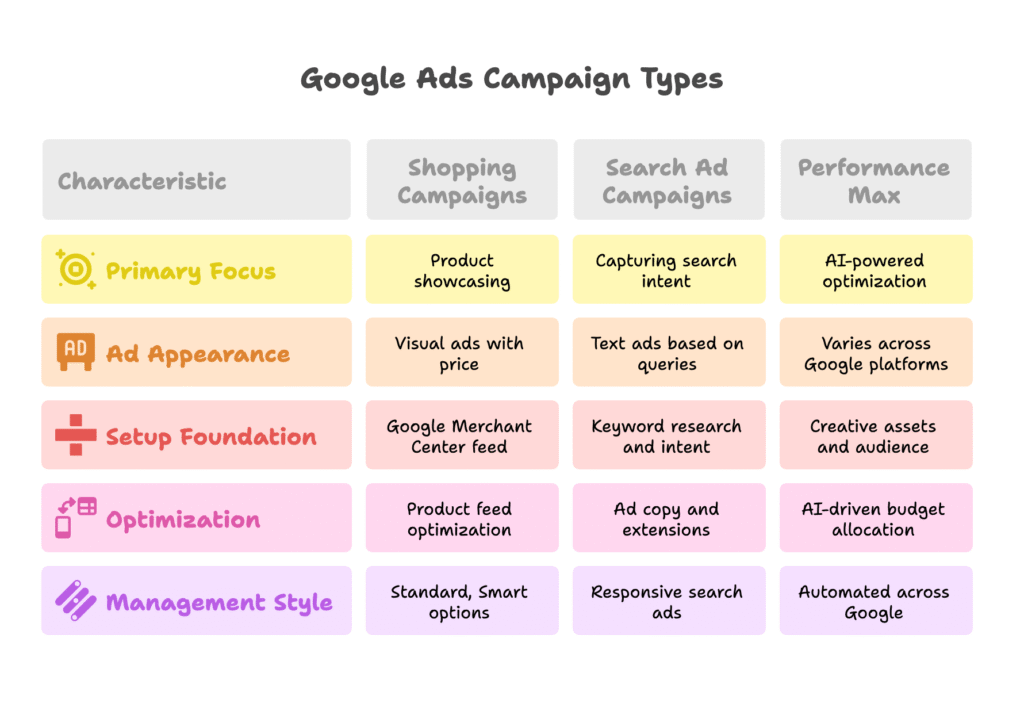
Shopping Campaigns: Showcasing Your Products
Google Shopping ads are visual, product-focused, and perfect for e-commerce. They appear at the top of search results with images, prices, and store names—exactly what shoppers want to see.
Setting up Google Merchant Center is your first step. Link it to your Shopify store, create a product feed, and optimize it meticulously. Your feed determines which searches trigger your ads, so accuracy is paramount.
Product titles in your feed should be descriptive and include relevant keywords. Instead of “Blue Dress,” use “Women’s Navy Blue Maxi Dress – Summer Cotton Casual Wear.” Include brand, color, size, material, and relevant attributes.
Your campaign structure options include Standard Shopping campaigns for maximum control, Performance Max campaigns for automated optimization across Google’s entire ecosystem, and Smart Shopping for hands-off management. Start with Standard Shopping to learn what works, then graduate to more automated solutions.
Search Ad Campaigns: Capturing Intent
Search ads appear when people type specific queries into Google. The key is understanding search intent and matching it with compelling ad copy.
Keyword research starts with thinking like your customers. What would someone type when looking for your products? Tools like Google Keyword Planner, Ubersuggest, or Ahrefs provide search volume and competition data.
Focus on high-intent keywords initially. “Buy organic dog food online” shows much stronger purchase intent than “pet nutrition.” Long-tail keywords often cost less and convert better than broad, competitive terms.
Your ad copy needs to stand out in a crowded search results page. Write headlines that include your target keywords and clear value propositions. Use all available ad extensions—sitelinks, callouts, structured snippets—to maximize your ad real estate.
Responsive search ads let Google test different combinations of headlines and descriptions automatically. Provide 8-15 headlines and 2-4 descriptions, ensuring each makes sense regardless of how they’re combined.
Performance Max: Google’s AI-Powered Solution
Performance Max campaigns represent Google’s vision of the future: AI-driven advertising that optimizes across Search, Shopping, Display, YouTube, and Gmail simultaneously.
Setting up Performance Max requires providing various creative assets—images, videos, headlines, descriptions, and logos. Google’s AI determines the best combinations for each placement and audience.
Audience signals help guide the algorithm initially. Upload your customer email lists, specify interests and demographics, and let the system learn from your inputs. Over time, Performance Max identifies patterns you might never discover manually.
Budget allocation happens automatically across all Google properties. You might see your budget shift from Search to YouTube or from Shopping to Display based on where conversions are happening most efficiently.
Conquering Meta Advertising (Facebook & Instagram)
Meta’s advertising platform offers unparalleled audience targeting and visual storytelling opportunities. With over 3 billion active users across Facebook and Instagram, your ideal customers are definitely there—the challenge is reaching them effectively.
Campaign Structure: The Foundation of Success
Campaign objective selection shapes everything about your ads. For Shopify stores, Conversions campaigns optimize for purchases, while Catalog Sales campaigns promote your entire product range dynamically.
The Meta advertising hierarchy—Campaign > Ad Set > Ad—allows for sophisticated testing and optimization. Campaigns determine objectives and budgets. Ad sets define audiences, placements, and scheduling. Individual ads contain your creative and copy.
Audience targeting is where Meta truly shines. Custom audiences let you target people who’ve visited your website, engaged with your content, or are in your email database. Lookalike audiences find new people similar to your best customers—often the most profitable audience segment.
Campaign Budget Optimization (CBO) automatically distributes your budget across ad sets to maximize results. While you can still set ad set budgets manually, CBO often delivers better performance by allocating more spend to what’s working.
Creative Strategies That Stop the Scroll
Social media is a visual medium. Your creatives make or break campaign performance. Users scroll quickly through their feeds—you have maybe two seconds to capture attention.
Image ads should showcase your products clearly and beautifully. Use high-quality photography with proper lighting and composition. Lifestyle images often outperform white background shots because they help customers envision using your products.
Video ads offer more storytelling opportunities. Start with a hook in the first 3 seconds—a surprising fact, visual effect, or compelling question. Demonstrate your product in action, highlight unique features, or share customer testimonials.
Carousel ads let you showcase multiple products or tell a sequential story. Product carousels work well for fashion and home decor brands, while story carousels can explain complex concepts or highlight different product benefits.
Your ad copy should complement, not repeat, your visuals. Include clear value propositions, address common objections, and always end with a specific call-to-action. Test different copy lengths—sometimes longer copy converts better because it qualifies traffic.
Advanced Meta Techniques for Scaling
Dynamic Product Ads (DPA) automatically show relevant products to people who’ve viewed them on your site. They’re particularly effective for retargeting cart abandoners or cross-selling to existing customers.
Setting up DPA requires connecting your Shopify product catalog to Meta Business Manager. The platform automatically creates ads featuring the exact products people viewed, often including real-time pricing and availability.
Advantage+ Shopping Campaigns represent Meta’s answer to Google’s Performance Max. These AI-driven campaigns optimize targeting, creative delivery, and budget allocation automatically across Facebook and Instagram.
Creative testing should be systematic, not random. Test one variable at a time—image vs. video, short copy vs. long copy, different audiences. Run tests for at least 7 days and ensure statistical significance before making decisions.
Exploring Additional Advertising Platforms
While Google and Meta dominate digital advertising, other platforms offer unique opportunities to reach your customers where competition is often lower and costs more affordable.
Pinterest: The Visual Discovery Engine
Pinterest users are actively seeking inspiration and ideas—perfect for product discovery. The platform works exceptionally well for fashion, home decor, food, and lifestyle brands.
Setting up Pinterest for Business involves claiming your Shopify domain and installing the Pinterest Tag for conversion tracking. The platform automatically creates Product Rich Pins from your Shopify catalog, displaying real-time pricing and availability.
Shopping campaigns on Pinterest showcase your products directly in users’ feeds and search results. Unlike other platforms, Pinterest content has a longer lifespan—Pins can drive traffic for months or even years after creation.
Your Pin creative should fit naturally into the Pinterest aesthetic. Use vertical images (2:3 aspect ratio), include text overlays with key product information, and ensure your branding is subtle but consistent.
TikTok: Authentic Engagement with Gen Z and Millennials
TikTok’s rapid growth makes it impossible to ignore. The platform’s algorithm favors engaging content over polished advertisements, creating opportunities for authentic brand connections.
TikTok Ads Manager offers several campaign objectives, but Conversions campaigns work best for Shopify stores. Install the TikTok Pixel through Shopify’s integration or manually add it to your theme.
In-Feed ads appear naturally in users’ For You pages. The key is creating content that doesn’t feel like advertising. Show real people using your products, share behind-the-scenes content, or participate in trending challenges.
Collection ads showcase multiple products in a shopping-focused format. They work well for fashion and lifestyle brands wanting to drive catalog browsing and purchases.
Working with TikTok creators often produces better results than brand-created content. Creators understand platform culture and can authentically introduce your products to their audiences.
Retargeting and Remarketing Excellence
Most website visitors don’t purchase on their first visit. Retargeting brings them back when they’re ready to buy. It’s often the most cost-effective advertising you can do.
Segmentation: Speaking to Where They Are
Effective retargeting starts with understanding the customer journey. Someone who viewed a single product page needs different messaging than someone who added items to cart but didn’t checkout.
Cart abandoners represent your hottest prospects. They’ve shown strong purchase intent but something prevented completion. Address common objections in your retargeting ads—shipping costs, return policies, or security concerns.
Product page visitors showed initial interest but need more convincing. Highlight unique selling points, show social proof, or offer additional product information they might have missed.
Previous customers deserve special treatment. Retarget them with complementary products, replenishment reminders for consumables, or exclusive loyalty offers.
Platform-Specific Remarketing Strategies
Google Ads remarketing lists can be based on specific pages visited, time spent on site, or actions taken. Create separate lists for different product categories to deliver relevant messaging.
Meta custom audiences offer incredible granularity. Create audiences based on specific products viewed, time since last visit, or purchase history. Exclude recent purchasers to avoid advertising fatigue.
Cross-platform remarketing ensures you reach customers wherever they spend time online. Someone who visited your site might see your Google ad during their next search and your Facebook ad later that evening.
Messaging Tailored to Purchase Stage
Awareness stage visitors need education about your brand and products. Focus on value propositions, brand story, and product benefits rather than aggressive sales messaging.
Consideration stage prospects are comparing options. Highlight what makes you different—better quality, superior service, stronger guarantees, or unique features competitors lack.
Decision stage visitors just need a gentle push. Limited-time offers, free shipping incentives, or extended return policies can overcome final hesitations.
Performance Measurement and Optimization
Data without action is just expensive noise. The most successful Shopify merchants obsess over their metrics and continuously optimize based on what they learn.
Key Performance Indicators That Matter
Click-through rate (CTR) indicates how compelling your ads are to your target audience. Industry averages vary, but consistently low CTRs suggest your targeting or creative needs improvement.
Cost-per-click (CPC) affects your budget efficiency. Higher CPCs aren’t necessarily bad if they drive quality traffic that converts. Monitor CPC trends to identify when competition increases or your relevance scores decline.
Conversion rate measures how effectively your landing pages turn visitors into customers. If your ads drive traffic but conversions lag, focus on website optimization rather than advertising changes.
Return on ad spend (ROAS) remains the ultimate measure of campaign success. Calculate ROAS by dividing revenue generated by advertising costs. Most profitable Shopify stores maintain ROAS above 4:1.
Customer lifetime value (CLV) considerations become important as you scale. Acquiring customers at break-even makes sense if they purchase repeatedly over time. Factor CLV into your target CPA calculations.
Analytics and Reporting Excellence
Shopify’s built-in analytics provide valuable insights, but external platforms offer deeper analysis. Set up proper attribution models to understand which touchpoints contribute to conversions.
UTM parameters help track campaign performance in Google Analytics. Use consistent naming conventions across all platforms to accurately compare channel performance.
Custom reports save time and highlight important trends. Create dashboards showing key metrics for each advertising platform, allowing quick performance assessment.
Multi-touch attribution models provide a more accurate picture than last-click attribution. Assisted conversions data shows how different channels work together throughout the customer journey.
Continuous Improvement Framework
Daily monitoring prevents small issues from becoming expensive problems. Check pending campaigns, review overnight performance, and pause underperforming ads quickly.
Weekly optimization sessions allow for strategic adjustments. Analyze performance trends, test new audiences or creative, and reallocate budgets based on recent data.
Monthly strategic reviews step back from day-to-day optimization to evaluate overall approach. Assess channel mix, update customer personas, and plan new campaign launches.
Creative refreshment prevents ad fatigue—the gradual decline in performance as audiences become familiar with your ads. Systematically test new images, videos, and copy to maintain peak performance.
Scaling Strategies for Growing Shopify Stores
Scaling successful campaigns requires careful methodology. Aggressive scaling can destroy performance as quickly as it increases volume. The art lies in finding the right balance.
Budget Scaling: Vertical vs. Horizontal Growth
Vertical scaling means increasing budgets on existing successful campaigns. Start with 20-30% daily budget increases, monitoring performance closely. Large budget jumps can trigger algorithm relearning periods that hurt performance temporarily.
Horizontal scaling involves expanding to new audiences, platforms, or campaign types. This approach reduces reliance on single campaigns while creating multiple growth opportunities.
Geographic expansion opens new markets for your products. Test new countries or regions with small budgets initially. Consider cultural differences, local competition, and shipping logistics when expanding internationally.
Automation for Efficiency
Automated rules handle routine optimization tasks, freeing you to focus on strategy. Set rules to pause poor-performing ads, increase budgets on winners, or adjust bids based on performance metrics.
Third-party tools like AdEspresso, Optmyzr, or Shopify Flow can automate complex optimization tasks across multiple platforms. These tools are particularly valuable for agencies or merchants managing numerous campaigns.
Smart Bidding strategies in Google Ads and automatic bidding in Meta Ads often outperform manual bid management at scale. Machine learning algorithms process more variables than humans can manage manually.
Learning from Success Stories
Ruby Olive increased revenue by 500% through strategic Meta advertising. They focused on video creative showcasing product benefits, targeted lookalike audiences based on their best customers, and continuously tested new ad formats.
LSKD’s mobile app strategy demonstrates the power of platform-specific optimization. They created separate campaigns for app installs vs. web conversions, optimized creative for mobile viewing, and implemented deep linking for seamless user experience.
Both success stories share common themes: relentless testing, customer-centric messaging, and platform-appropriate creative strategies. They also maintained focus on long-term customer value rather than short-term conversion metrics.
Conclusion: Your Paid Advertising Success Path
Paid advertising for Shopify stores isn’t about choosing the perfect platform or finding magical keywords. Success comes from understanding your customers deeply, testing systematically, and optimizing relentlessly.
Start with solid tracking foundations—you can’t optimize what you can’t measure. Choose platforms where your customers spend time, not where you think they should be. Focus on one or two channels initially rather than spreading efforts too thin.
Remember that advertising is a conversation with your audience. Listen to what your data tells you about their preferences, behaviors, and motivations. Adjust your messaging based on their responses, not your assumptions.
Brand protection and performance aren’t mutually exclusive. The most successful merchants find ways to drive growth while maintaining the premium perception their customers expect. Smart targeting, authentic creative, and value-focused messaging achieve both goals simultaneously.
Your advertising journey is marathon, not a sprint. Build sustainable systems, maintain consistent testing schedules, and focus on incremental improvements rather than dramatic overhauls. The merchants who embrace this mindset build lasting, profitable advertising engines that fuel long-term growth.
References
- Shopify Blog. (2025). “What Is Paid Advertising? Definition, How It Works and Platforms.” https://www.shopify.com/blog/paid-advertising
- Shopify Blog. (2024). “Google Shopping Ads: How It Works, Tips and Best Practices.” https://www.shopify.com/blog/shopping-ads-google
- Fly High Media. (2024). “Mastering Shopify PPC: The Ultimate Guide.” https://www.flyhighmedia.co.uk/blog/mastering-shopify-ppc-a-complete-guide/
- Evolvbam. (2025). “12 Shopify Advertising Strategies that Drive Sales in 2025.” https://www.evolvbam.com/post/shopify-advertising-strategies
- Promodo. (2024). “How to Run Ads for Shopify Store: Essential Strategies for Success.” https://www.promodo.com/blog/how-to-run-ads-for-shopify-store-essential-strategies-for-success
- Its Fun Doing Marketing. (2025). “30+ Best Shopify Case Studies on Growth You’ll Enjoy Reading.” https://www.itsfundoingmarketing.com/blog/shopify-case-studies
Ready to supercharge your Shopify store’s sales with perfectly optimized discount strategies? Growth Suite is a Shopify app that intelligently targets hesitant visitors with personalized, time-limited offers—boosting conversions without devaluing your brand. Install it with a single click and start seeing results immediately!
